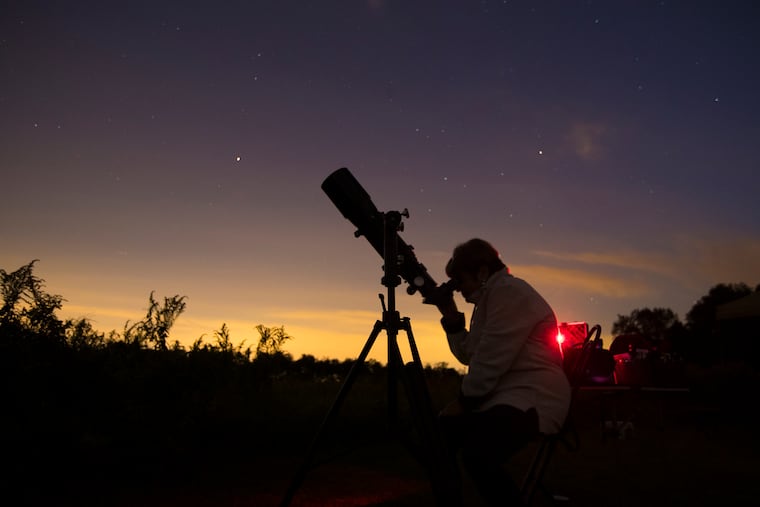You can watch a NASA rocket launch in Philly
If skies remain clear, NASA predicts the craft carrying supplies to International Space Station will be visible in Philly around 4:02 a.m. Saturday morning.

NASA is set to launch its Northrop Grumman Antares rocket Saturday morning in Virginia, but Philadelphians won't have to go far to see a piece of the action.
If skies remain clear, NASA predicts the craft carrying supplies to the International Space Station will be visible in Philadelphia about 4:02 a.m. Saturday.
Or rather, the flame from the rocket booster will be visible, said Derrick Pitts, chief astronomer at the Franklin Institute.
"It's quite specific what you see," he explained. "It's like you're watching an orange dot moving across the sky. … If you can find it with a pair of binoculars, you can watch it for more than a minute. That first stage burns for 3.5 minutes."
According to NASA, early risers along much of the East Coast will be able catch a glimpse of the unmanned cargo ship. The farther you move from the launch point in Wallops Island, Va., the closer the craft will appear to the horizon, Pitts said.
From the Philadelphia area, the spacecraft can be seen from around five degrees above the horizon to the south, Pitts said, pointing to the New Jersey Shore and in particular Cape May as prime rocket viewing spots.
The less light pollution, the better visibility, he added.
Rocket sightings over Philadelphia and the East Coast have become more common since NASA shut down its Space Shuttle program in 2011, forcing larger rockets from Florida to launch more frequently at the Wallops Flight Facility on Virginia's Eastern Shore, Pitts explained.
Carrying nearly four tons of supplies and materials to crews aboard the International Space Station, the Cygnus spacecraft was originally scheduled to launch early Thursday but was pushed back to Friday and again to Saturday due to unfavorable weather conditions.
And among the supplies on the craft is some precious cargo for Earth-friendly space dwellers, including a "refabricator" 3D printing machine to help astronauts reuse plastic on the ISS, as well as materials for experiments on human muscular tissue in microgravity, a protein closely associated with the development of Parkinson's disease, and the production of cost-effective membranes that could one day be used to reduce greenhouse gas emissions, according to the Salisbury Daily Times.
So who's waking up at 4 a.m. on a Saturday to catch a glimpse of the space-bound science? A lot of people, apparently.
Near the Wallops Flight Facility in Chincoteague, Va., area hotels are a hot commodity as rocket enthusiasts flock to the region to watch the launch, the Times reported.
And in Jenkintown, space enthusiast Aly Lester and her family will wake up before the sun to head to a nearby football field and catch the action.
Lester, a civil engineer, and her husband first started watching for rockets after a trip through Wallops Island several years ago.
"We just thought it was so cool," Lester said, remembering the last Antares rocket launch she her husband and two children viewed from Philadelphia. "There's an app that you can install in your phone that points you due south. We sat in an open field and could see it clearly."
Sometimes, the craft's launch is canceled last minute due to factors like inclement weather, but that hasn't dampened Lester's enthusiasm.
"You have to be very, very patient, but it's so worth it when you see it," she said. "One day we hope to drive down and see it up close."